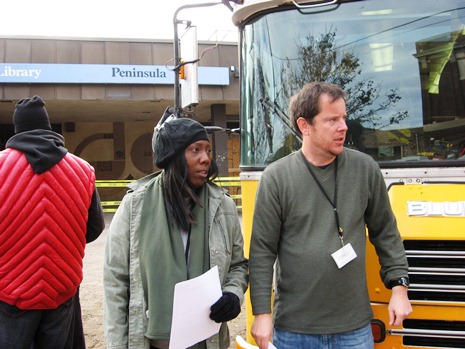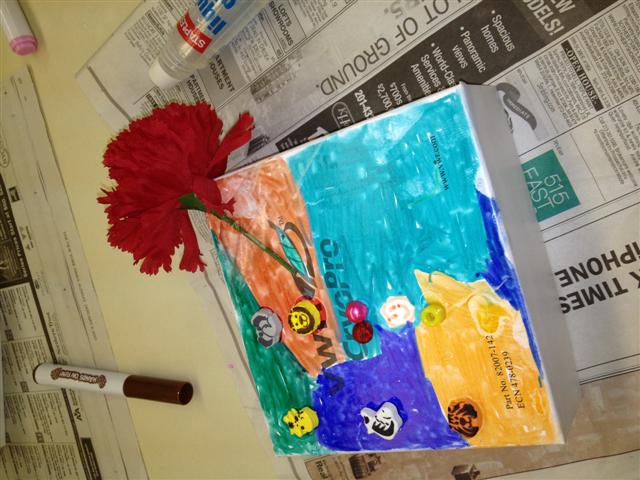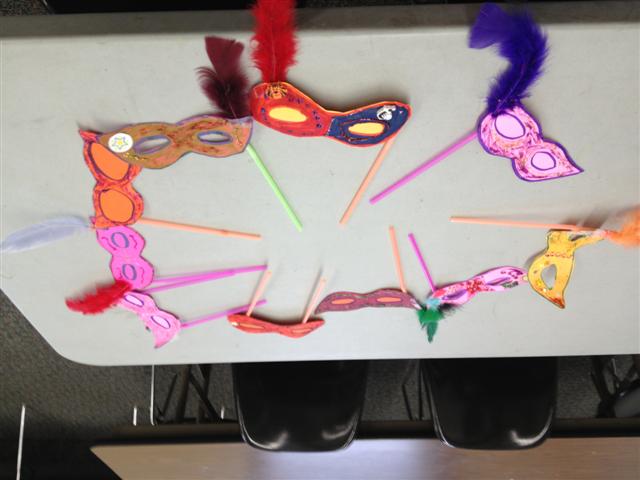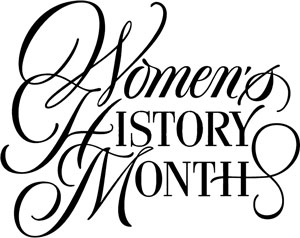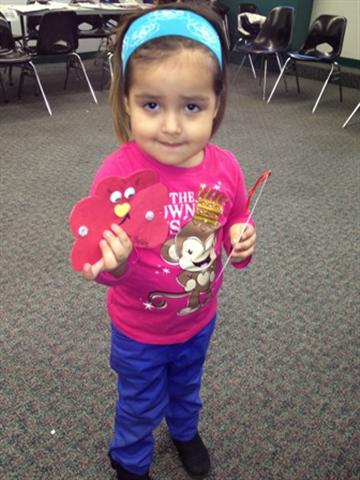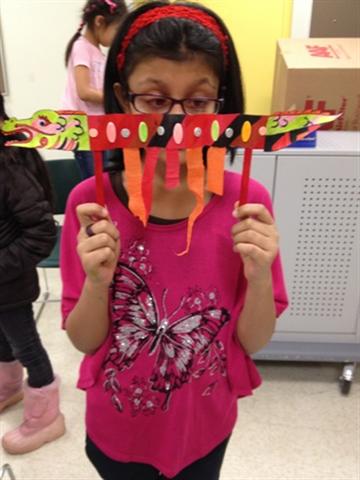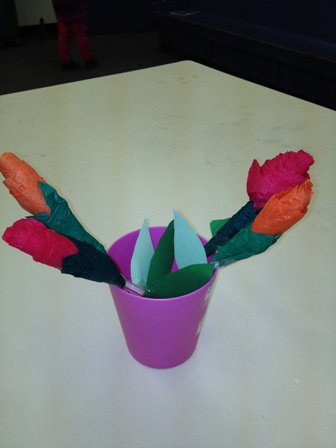To celebrate Dr. Seuss’s birthday, on March 2, Queens Libraries at Woodside and Broadway invited children and their caregivers to make 3D aquariums, inspired by Seuss’s book One Fish, Two Fish, Red Fish, Blue Fish, a children’s book that teaches readers simple rhymes. Dr. Seuss, whose real name is Theodor Seuss Geisel, was a beloved American author and poet known for his zany and outlandish characters. March 2 was adopted as the annual date for National Read Across America Day, an initiative created by the National Education Association to promote literacy. Eco-arts fans: All the paper used for this craft came from old posters and flyers.
It has been months since Superstorm Sandy devastated the East Coast, and things are still far from back to normal in the Rockaways. At the Peninsula Library where I work as the manager, we served the community from a book bus for nearly two months. Priorities have changed several times since then, but the strong focus has always been on helping people in the area.
Sandy sent 4 feet of dirty salt water through the plate glass windows of our library, destroying everything. Our library wasn’t the only one, either. Queens Library at Arverne was devastated by a similar storm surge. Libraries at Seaside and Broad Channel were flooded by lower storm surges, destroying books and furniture.
When Queens Library reopened boroughwide a few days after Sandy , we didn’t quite know what to expect. We were told that many staff members whose libraries were ruined would be assigned to the mobile library being sent to operate outside the Peninsula Library. It turned out that I was headed right into the middle of it.
I’ve only been the library manager at Peninsula since April 2012, but I have a strong connection to the Rockaways. Before Peninsula, I spent 2 ½ years as the manager of the Seaside Library. I proudly took part in the Boardwalk for Books rally we held last year to protest the city’s planned budget cuts to Queens Library. At Peninsula we had built up momentum and were improving services. Recently we added a specialized program, which offers more intense instruction in jobs and technology skills.
A lot of people have asked about my reaction to losing a library, but I mostly cared about whether everyone was okay. I knew that several staff lived in the Rockaways, and I was also concerned about customers I saw regularly.
On the morning of November 2nd, I watched out the window of the Q53 as the bus headed south through Queens. By the time it got to Broad Channel, I could see the devastation: cars pushed into poles, boats lying in the middle of streets, debris everywhere. When the bus came off the Cross Bay Bridge into the Peninsula, I knew that the area was in really bad shape.
When I reported to work, a thick layer of dirt coated the sidewalk in front of the ruined library. My colleagues, Lauren Comito, Tara Lannen-Stanton, Seaside Library manager Kacper Jarecki, and others were there. They had printouts for FEMA, election information, and emergency services. They really understood the need for reliable information.
The next three weeks on the book bus were a blur. Some library workers volunteered on their days off in order to provide seven-day service. Tara Lannen-Stanton donated her coffee maker so everyone could have hot beverages. Kacper Jarecki played scrabble with customers and staff. I think drinking coffee and just talking made the situation a lot better. Information literally was block to block, and people were confused. On Election Day we directed hundreds of people 10 blocks west to their new polling site. People were very appreciative of any help, so I felt we were making a difference.
In December there was a shift. Maybe more locals had their power back, but we became busier with usual library services as opposed to emergency services. A lot of people lost library books and movies in the storm, or stayed away until recently. I’m glad we were able to clear up people’s accounts, and make it so customers did not have to worry about owing the library money for books damaged from the storm. I’m amazed at how many people felt it important to have their library accounts in good standing when they had so many other losses at this time.
As you might imagine, the demand for books soars when a community has no electricity. A lot of local people were generous with donating books to us. Urban Librarians Unite, a nonprofit in the NYC area, donated books to us and other sites. A company called Literacy in Motion dropped off a truck full of book donations, which we are still sorting through. Our customers have been very grateful. It has been a joy to see people excited about choosing books for their personal collections.
We took a step towards normalcy on January 8, when we moved service to a temporary trailer at Peninsula. We got a total of six full time staff, more room, and more of a collection. We still need a larger collection and space for services but one thing is clear: no matter how long it takes to rebuild, we will be here.
What’s going on at Peninsula this week? Check out our Events page. For more Queens Library programming in the Rockaways, check out Queens Library at Far Rockaway. For those still recovering from Sandy’s effects, that library also offers special open computer lab time.
Want to know what you can do to help Queens Library? Visit https://foundation.queenslibrary.org to learn more.
Queens Library at Steinway invited children to decorate their own keepsake boxes, re-purposing discarded ones that had been donated to the Materials for the Arts. Recycled materials, also from Materials for the Arts, were used to adorn and design the boxes. What do you think of the results of our eco-arts project?
To learn about and celebrate the Lunar New Year, Queens Library at Steinway invited children to make Chinese lanterns by upcycling paper from a Chinese calendar. Using a simple paper fold, some cutting here and there, and pasting techniques, children ended up with unique lanterns to take home.
To celebrate Carnival, Queens Library at Astoria invited our young customers to make masks out of recycled materials. We got into the spirit of the festive occasion by decorating our masks with glitter, ribbons, feathers and stickers. We even made a handy handle out of straws. We're grateful to Materials for the Arts for providing our supplies.
“How important it is for us to recognize and celebrate our heroes and she-roes!” –Maya Angelou
This Women's History Month, we're offering plenty of opportunities to recognize and celebrate she-roes!
Women's History Month Quiz and Raffle, all month, Queens Library at Ridgewood
Find the Women's History Month "Question of the Day" located on the Children's Reference Desk, answer it correctly, and get a chance to win free tickets to the American Museum of Natural History. Drawings will be held Fridays at 4:30 p.m. in March. You must be present at the raffle drawing to win. See the Children's Librarian for details.
Women's History Month Game, 3/4 and 3/11, Queens Library at McGoldrick
Test your knowledge of famous women in our who's who game!
Forgotten Pioneers: Women of Rockaway Beach, 3/4, Queens Library at Peninsula
Join Vivian Rattay Carter for an illustrated talk about the women of Rockaway Beach who were instrumental in establishing hospitals, churches and schools and operated hotels, rooming houses and restaurants dating back to the 1850s. Space is limited. Preregistration is required.
Women’s History Month Activity, 3/7, Queens Library at Hollis
Children will create a rocket from construction paper and learn about astronauts Ellen Ochoa, Mae Jemison and Sally Ride.
Women's History Month, 3/8, Queens Library at Central
Learn about famous, creative and talented women while enjoying games, crafts and stories for children ages 6-12 years.
Hands on the Freedom Plow, 3/16, Queens Library at Central
Meet three Student Nonviolent Coordinating Committee women: Dr. A. Leonara Taitt-Magubane, Muriel Tillinghast and Angeline Butler; the latter two are part of the 52 women whose personal stories are documented in Hands on the Freedom Plow, which documents the pivotal role women played early in the Civil Rights Movement.
The Other Black New Yorkers: New Stories of Exceptional Women, 3/16, Queens Library at Langston Hughes
This illustrated talk will feature the African-American history of New York City from Dutch colonialism to the present. We will highlight African-American women to the sound of a century of great music!
Great Ladies of Jazz, 3/19, Queens Library at Lefrak City
This is a tribute to Billie Holiday, Ella Fitzgerald, Lena Horne, Sarah Vaughn, Carmen McRae, Dinah Washington, Betty Carter and Nancy Wilson, trailblazers and ambassadors of jazz, the great American art form.
Children at Queens Library at Woodside got into the spirit of celebrating Valentine's Day by combining heart shapes cut from recycled pink paper and googily eyes to create their own unique Valentine's Day buddies.
In honor of the Lunar New Year, Queens Library at Sunnyside introduced children and their caregivers to Chinese culture through the art of making environmentally-friendly dragon puppets out of recycled paper, popsicle sticks and streamers. As the Lunar New Year's custom goes, two people get inside of a huge lion or dragon costume and perform a dance. The craft we made for the holiday is a tiny paper version of this traditional puppet. Happy Chinese New Year, or Gung Hay Fat Choy, to you. All the best to you in the year of the Snake!
To help celebrate American Heart Month and raise awareness of heart disease, children and their caregivers made 3-D hanging-heart crafts at Queens Library at Woodside. See the end result--made using red recycled postcards, red string and glittery stickers--pictured here.
To celebrate the holiday, Queens Library at Woodside invited children and their caregivers to make their own Valentine’s Day roses out of recycled materials, crepe paper and straws. Using an upward wrapping technique participants made roses like the lovely ones pictured here. Eco-arts fans: The leaves are made from recycled paper. Streamers and tissue paper can also be used for the petals, if crepe paper is not available.

